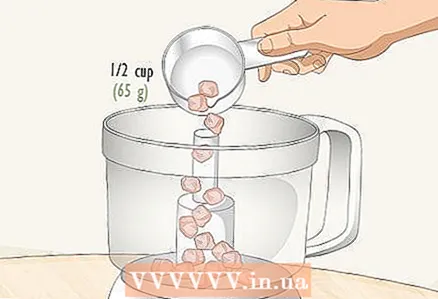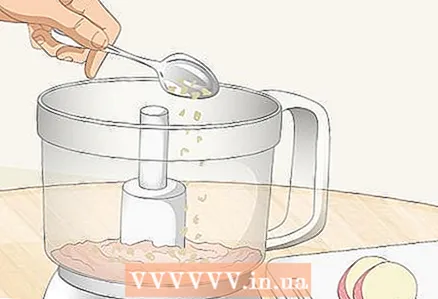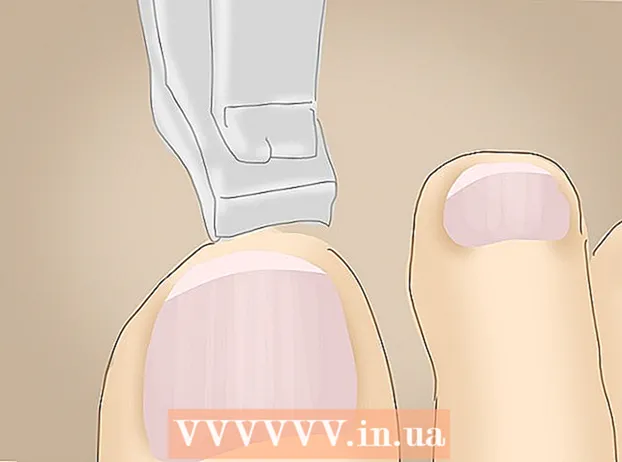
Content
- Ingredients
- Steps
- Part 1 of 3: Cooking chicken
- Part 2 of 3: Making Simple Chicken Puree
- Part 3 of 3: Possible Additives in Purees
- Tips
- What do you need
According to the American Academy of Pediatrics, children can be fed chicken as soon as they are ready to sample solid foods, which is about 4-6 months old. Delicate chicken puree is not only easy food for babies, but also an excellent source of essential vitamins and minerals such as iron and zinc. To make chicken puree for a young child, you need to boil the chicken and then grind it in a blender or food processor with a little liquid. You can also make the puree more flavorful and nutritious by adding spices, juice, or your child's favorite fruits or vegetables.
Ingredients
- 1-2 boiled boneless, skinless chicken thighs
- 4-6 tablespoons (60-90 milliliters) water, boiled broth, or juice
- 1 pinch of mild herbs or spices, such as garlic powder, rosemary, or parsley (optional)
- 1/4 cup (45 grams) steamed fruit or vegetables (optional)
Steps
Part 1 of 3: Cooking chicken
 1 Choose dark chicken meat as it contains a lot of iron. Babies who are breastfeeding benefit from foods rich in iron and zinc. Although white chicken contains less fat, dark meat is healthier for a child as it is richer in iron and antioxidants. Take a piece with dark meat, such as thighs or legs.
1 Choose dark chicken meat as it contains a lot of iron. Babies who are breastfeeding benefit from foods rich in iron and zinc. Although white chicken contains less fat, dark meat is healthier for a child as it is richer in iron and antioxidants. Take a piece with dark meat, such as thighs or legs. - Since most infant formulas are fortified with iron and other important micronutrients, if you feed your baby with formula, he is unlikely to need the additional iron found in dark meats. Talk to your pediatrician about which meat is best for your child, dark or white.
- Chicken thighs also contain more fat than breasts, making them easier to puree and tastier.
- It will take 1–2 thighs to cook about ½ cup (about 65 grams) of chicken puree. One thigh with bones and skin weighing 170 grams will make about 85 grams of meat, but you will need more smaller thighs.
 2 Remove all bones and skin. Try to get boneless and skinless chicken. If this is not possible, remove the skin from the meat and cut it from the bones.
2 Remove all bones and skin. Try to get boneless and skinless chicken. If this is not possible, remove the skin from the meat and cut it from the bones. - Chicken skin is poorly processed into puree. If you leave the skin on, large pieces of it will get into the puree, which can choke on the child.
 3 Cut the meat into small pieces. Before boiling the chicken, cut it into small cubes or slices with a sharp knife. Place the meat on a cutting board and cut into strips 1-1.5 centimeters wide, then cut them across into cubes.
3 Cut the meat into small pieces. Before boiling the chicken, cut it into small cubes or slices with a sharp knife. Place the meat on a cutting board and cut into strips 1-1.5 centimeters wide, then cut them across into cubes. - To make it easier to cut meat, place it in the freezer 15 minutes before cutting.
- Be careful when using a sharp knife. Curl your fingertips as you grip the meat to avoid accidentally cutting yourself.
 4 Place the meat in a saucepan and cover with water or broth. Place the finely chopped chicken in a saucepan and add the water so that it completely covers the meat. The broth will give the meat a richer flavor, although when the chicken is boiled it will form its own broth.
4 Place the meat in a saucepan and cover with water or broth. Place the finely chopped chicken in a saucepan and add the water so that it completely covers the meat. The broth will give the meat a richer flavor, although when the chicken is boiled it will form its own broth. Advice: If you wish, you can fry the chicken or cook it in a pressure cooker. Note that fried chicken may require more liquid to make a delicate puree.
 5 Bring water in a saucepan to a boil. Place the pot on the stove and turn on medium to high heat. Cover the pot and wait for the water to boil.
5 Bring water in a saucepan to a boil. Place the pot on the stove and turn on medium to high heat. Cover the pot and wait for the water to boil. - The time required depends on how much liquid is in the pot. Look into the pot often so you don't miss the time and don't overcook the meat.
 6 Reduce heat and simmer the chicken in low-boiling water for 15–20 minutes. When the liquid boils, turn the heat to low. Cover the saucepan and cook the meat over low heat until it is no longer pink and releases clear juice when cut. This should take about 15-20 minutes.
6 Reduce heat and simmer the chicken in low-boiling water for 15–20 minutes. When the liquid boils, turn the heat to low. Cover the saucepan and cook the meat over low heat until it is no longer pink and releases clear juice when cut. This should take about 15-20 minutes. - Be careful not to overcook the chicken, otherwise it will become tough and "rubbery".
Part 2 of 3: Making Simple Chicken Puree
 1 Leave in 4-6 tablespoons (60-90 ml) of broth. You will need a little liquid for the puree. Leave some stock to add to the meat when you puree in a blender or food processor.
1 Leave in 4-6 tablespoons (60-90 ml) of broth. You will need a little liquid for the puree. Leave some stock to add to the meat when you puree in a blender or food processor. - Chicken broth will add extra flavor to the puree and will preserve some of the nutrients that were in the water when cooking the meat.
Advice: If the child has not tried chicken yet, the chicken broth can make the puree taste too rich. If your child doesn't like it, try making the chicken puree with water or juice.
 2 Place 1/2 cup (65 grams) cooked chicken in blender or food processor. Place the cooked meat cubes in a glass of a food processor or blender. If you've just cooked the meat, wait a few minutes for it to cool.
2 Place 1/2 cup (65 grams) cooked chicken in blender or food processor. Place the cooked meat cubes in a glass of a food processor or blender. If you've just cooked the meat, wait a few minutes for it to cool. - Wait for the meat to cool down to the point where you can touch it.
- Remember to assemble your blender or food processor before placing meat in it!
 3 Add 2–3 tablespoons (30–45 milliliters) of liquid. Add a couple of tablespoons of broth to the meat before you start making the puree. This will moisten the chicken and the puree will be more tender.
3 Add 2–3 tablespoons (30–45 milliliters) of liquid. Add a couple of tablespoons of broth to the meat before you start making the puree. This will moisten the chicken and the puree will be more tender. - Do not add all of the liquid in one go. You may need less stock, otherwise the puree will be too runny.
 4 Cover your blender or food processor. Do not press any buttons until the lid is secured, otherwise the contents of the glass may spill out and splatter everything around!
4 Cover your blender or food processor. Do not press any buttons until the lid is secured, otherwise the contents of the glass may spill out and splatter everything around! - Some food processors have a feed chute through which you can add ingredients as you work. If your food processor does not have one, you will need to stop it and remove the lid to add liquid or other ingredients.
 5 Press the Pulse button until the meat is chopped into smaller pieces. Instead of trying to puree straight away in a blender or food processor, you can press the Pulse button several times to pre-grind the meat into small pieces.
5 Press the Pulse button until the meat is chopped into smaller pieces. Instead of trying to puree straight away in a blender or food processor, you can press the Pulse button several times to pre-grind the meat into small pieces. - Using the Pulse button will help you chop the meat more evenly.
 6 Grind the meat until smooth and smooth. Turn on the puree option and chop the chicken and broth until smooth. Check the puree from time to time to see if it has reached the desired consistency and if there are any lumps or other irregularities in it.
6 Grind the meat until smooth and smooth. Turn on the puree option and chop the chicken and broth until smooth. Check the puree from time to time to see if it has reached the desired consistency and if there are any lumps or other irregularities in it. - This process should take a few minutes, although the exact time will vary depending on the model of blender or food processor.
 7 Add the remaining liquid, little by little, if necessary. If there is not enough liquid, the puree will come out dry or grainy. If you think you need more liquid, add broth or water in small portions until you get the consistency you want.
7 Add the remaining liquid, little by little, if necessary. If there is not enough liquid, the puree will come out dry or grainy. If you think you need more liquid, add broth or water in small portions until you get the consistency you want. - Don't add too much liquid or the puree will end up watery.
- If the puree is too runny, you can add some chicken.
Part 3 of 3: Possible Additives in Purees
 1 Add juice instead of broth or water for a different flavor. If your child doesn't like plain chicken puree, you can use a different liquid to hide or enhance the flavor. Try adding some apple or white grape juice to the puree instead of broth or water, or mix the juice with the broth.
1 Add juice instead of broth or water for a different flavor. If your child doesn't like plain chicken puree, you can use a different liquid to hide or enhance the flavor. Try adding some apple or white grape juice to the puree instead of broth or water, or mix the juice with the broth. - To avoid giving your child too much sugar, use pure, unsweetened juice.
 2 Add some mild herbs or spices for extra flavor. While you may hesitate to feed your baby something with spices, experimenting with different additives and textures will help develop his taste. Add a dash of mild seasoning such as black pepper, garlic powder, basil, or rosemary for a richer flavor.
2 Add some mild herbs or spices for extra flavor. While you may hesitate to feed your baby something with spices, experimenting with different additives and textures will help develop his taste. Add a dash of mild seasoning such as black pepper, garlic powder, basil, or rosemary for a richer flavor. - First, use a small amount of a particular spice so that the child gets used to its taste.
- Use the seasoning after your child tastes pure chicken puree, and add no more than one ingredient at a time. If your child is allergic to any food or seasoning, this will help determine which ingredients should be avoided in the future.
Advice: fresh or dried herbs can be added to baby food. If you choose to use fresh herbs, grind the leaves well so that the child does not choke on the large chunks.
 3 Add the fruit or vegetable pureeto get additional nutrients. Chicken puree will be tastier and more nutritious if you add fruits and vegetables to it. Before you puree fruits or vegetables, cut them into small pieces and cook to soften them.
3 Add the fruit or vegetable pureeto get additional nutrients. Chicken puree will be tastier and more nutritious if you add fruits and vegetables to it. Before you puree fruits or vegetables, cut them into small pieces and cook to soften them. - It is best to steam your fruit or vegetables rather than boil them to preserve flavor and nutrients.
- Place about 1/4 cup (about 45 grams) of cooked fruits or vegetables along with the chicken in a blender or food processor.
- Try adding apples, pears, carrots, sweet potatoes, peas, or spinach to your chicken.
- Add only 1 ingredient at a time so you can determine what your child is allergic to.
Tips
- Chicken puree can be stored in the refrigerator for up to 24 hours or in the freezer for up to 1 month. After you feed your baby, discard any leftover puree that is contaminated with the spoon and the baby's saliva.
What do you need
- Sharp kitchen knife
- Small saucepan
- Blender or food processor



